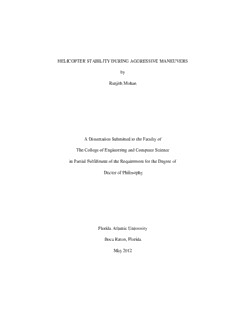
Helicopter stability during aggressive maneuvers PDF
Preview Helicopter stability during aggressive maneuvers
HELICOPTER STABILITY DURING AGGRESSIVE MANEUVERS by Ranjith Mohan A Dissertation Submitted to the Faculty of The College of Engineering and Computer Science in Partial Fulfillment of the Requirement for the Degree of Doctor of Philosophy Florida Atlantic University Boca Raton, Florida May 2012 HELICOPTER STABILITYDURING AGGRESSIVEMANEUVERS by Ranjith Mohan This dissertation was prepared under the direction ofthe candidate's dissertation advisor, Dr. Gopal H. Gaonkar, Department ofOcean and Mechanical Engineering, and has been approved by the members of his supervisory committee. It was submitted to the faculty of the College of Engineering and Computer Science and was accepted" in partial] fulfillment ofthe requirements for the degree ofDoctorof Philosophy. . Gopal H. nkar, Ph.D. GUOq~ Chaouki Ghen~ 1dA- .. WilliamD. Kalies, Ph.D. ohannnad as, .D. Interim Dean, The College of Engineering and Co~er Science -p~t£/2e~ 11 ACKNOWLEDGEMENTS This work was sponsored by the Army Research Office under Grant W911NF-07-1-0154. I am grateful to Mr. Thomas Maier, Chief of Aeromechanics, Aeroflightdynamics Directorate at the Ames Research Center (AFDD) and to Dr. Robert Ormiston, Chief Scientist, AFDD, for their understanding throughout the performance of this research. In particular, I gratefully acknowledge the 1) Permission to use RCAS and install it in the Helicopter Lab at FAU, and 2) Permission to access the UH-60A flight test database. Mr.Robert Kufeld, AFDD, kindly provided the guidance for accessing this UH-60A database. The guidance of Dr. Hossein Ali Saberi, Advanced Rotorcraft Technology, Inc, Sunnyvale, CA, in the effective use of RCAS is gratefully acknowledged. I thank ONERA, and specifically Dr. V.K. Truong, for their help with dynamic stall modeling. I am also grateful to Prof. David A. Peters of Washington University in St. Louis for his comments and suggestions. I also thank Maryam Khoshlahjeh, Graduate student, The Pennsylvania State University for the fruitful discussions on RCAS. I am grateful to the dissertation committee members for their patience and support. The Dean’s office and the Department of Ocean and Mechanical Engineering provided the assistantship and tuition waivers; this is gratefully acknowledged. Thanks are due to technical services group at FAU, specially, James Mauser and Scott Ridenour for supporting my computational needs. I thank my family and friends for their help and support. iii Finally, I thank my dissertation advisor, Prof. Gopal Gaonkar for the guidance and help he has been offering from the day one we met. iv ABSTRACT Author: Ranjith Mohan Title: Helicopter Stability During Aggressive Maneuvers Institution: Florida Atlantic University Dissertation Advisor: Dr. Gopal H. Gaonkar Degree: Doctor of Philosophy Year: 2012 The dissertation investigates helicopter trim and stability during level bank-angle and diving bank-angle turns. The level turn is moderate in that sufficient power is available to maintain level maneuver, and the diving turn is severe where the power deficit is overcome by the kinetic energy of descent. The investigation basically represents design conditions where the peak loading goes well beyond the steady thrust limit and the rotor experiences appreciable stall. The major objectives are: 1) to assess the sensitivity of the trim and stability predictions to the approximations in modeling stall, 2) to correlate the trim predictions with the UH-60A flight test data, and 3) to demonstrate the feasibility of routinely using the exact fast-Floquet periodic eigenvector method for mode identification in the stability analysis. The UH-60A modeling and analysis are performed using the comprehensive code RCAS (Army's Rotorcraft Comprehensive Analysis System). The trim and damping predictions are based on quasisteady stall, ONERA-Edlin v (Equations Differentielles Lineaires) and Leishman-Beddoes dynamic stall models. From the correlation with the test data, the strengths and weaknesses of the trim predictions are presented. vi HELICOPTER STABILITY DURING AGGRESSIVE MANEUVERS List of Tables ...................................................................................................................... xi List of Figures .................................................................................................................... xii Nomenclature .................................................................................................................. xvii Chapter 1 ............................................................................................................................. 1 1. Introduction ................................................................................................................. 1 1.1 Literature Review ................................................................................................. 2 1.1.1 Dynamic Stall ................................................................................................ 3 1.1.2 Dynamic Wake or Inflow .............................................................................. 6 1.1.3 Computational Aspects of Stability Analysis ................................................ 7 1.1.4 CSD/CFD Coupling ....................................................................................... 8 1.1.5 Mode Identification ....................................................................................... 8 1.1.6 Resonance ...................................................................................................... 9 1.1.7 Database ...................................................................................................... 11 1.2 Objectives and Scope .......................................................................................... 12 Chapter 2 ........................................................................................................................... 14 2. Floquet Theory and Periodic Eigenvector Methods .................................................. 14 2.1 Floquet Theory .................................................................................................... 14 2.2 Floquet Eigenvector Method .............................................................................. 15 vii 2.3 Fast-Floquet Theory ............................................................................................ 17 2.4 Fast-Floquet Periodic Eigenvector Method ........................................................ 19 Chapter 3 ........................................................................................................................... 26 3. Aerodynamic Modeling ............................................................................................. 26 3.1 Dynamic Stall Modeling ..................................................................................... 26 3.1.1 ONERA-Edlin (Equations Differentielles Lineaires) Model ...................... 26 3.1.2 ONERA-BH (Bifurcation de Hopf) Model ................................................. 32 3.1.3 Leishman-Beddoes Model ........................................................................... 38 3.1.4 Dynamic Stall Model in RCAS ................................................................... 41 3.2 Dynamic Inflow Modeling .................................................................................. 41 Chapter 4 ........................................................................................................................... 45 4. Isolated Rotor Flap-Lag Stability .............................................................................. 45 4.1 Modeling the Rotor ............................................................................................. 45 4.1.1 Test Model, Database and Damping Prediction .......................................... 45 4.1.2 Structural Model .......................................................................................... 46 4.1.3 Aerodynamic Model .................................................................................... 50 4.1.4 Aerodynamic Loading ................................................................................. 53 4.2 Results on Comparison of Dynamic Stall Model ............................................... 55 4.2.1 Correlating the Lag Damping Predictions ................................................... 55 4.3 Modifications in Comprehensive Analysis Code ............................................... 65 Chapter 5 ........................................................................................................................... 69 viii 5. Floquet Mode Identification Results ......................................................................... 69 5.1 Mode Identification for Isolated Rotors .............................................................. 69 5.1.1 Four-bladed flap degree-of-freedom rotor ................................................... 69 5.1.2 Four-bladed flap-lag degree-of-freedom rotor ............................................ 81 5.2 Coupled Rotor-Body ........................................................................................... 88 5.2.1 Aeromechanical Stability in Hover ............................................................. 88 5.2.2 Aeromechanical Stability under Ground Contact ........................................ 90 5.3 Aeromechanical Stability in Forward Flight ...................................................... 98 Chapter 6 ......................................................................................................................... 101 6. UH-60A Helicopter ................................................................................................. 101 6.1 UH-60A RCAS Model ...................................................................................... 101 6.1.1 UH-60A rotor model ................................................................................. 101 6.1.2 UH-60A complete helicopter model ......................................................... 101 6.2 Level flight ........................................................................................................ 106 6.2.1 Trim Predictions ........................................................................................ 106 6.2.2 Stability Margin ......................................................................................... 113 6.3 Level turns ........................................................................................................ 116 6.3.1 Trim Predictions ........................................................................................ 117 6.3.2 Stability Prediction .................................................................................... 123 6.4 Diving Bank-Angle turns .................................................................................. 124 ix 6.4.1 Trim predictions for diving bank-angle turns ............................................ 124 6.4.2 Stability Prediction .................................................................................... 133 Conclusions ..................................................................................................................... 138 Future work ..................................................................................................................... 140 Appendix A ..................................................................................................................... 141 References ....................................................................................................................... 149 x
Description: